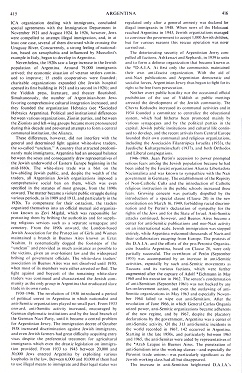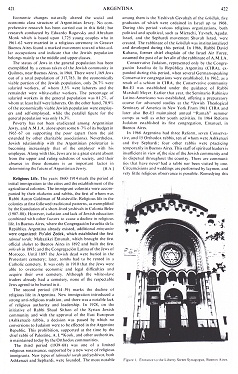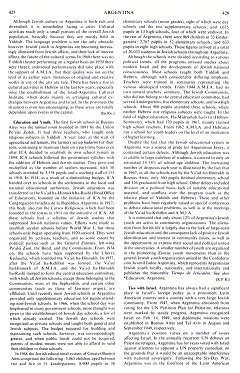[1917-1919: The Russian
revolution provokes anti-Semitism against the "Russians"
in Argentina - anti communist reflex leads into pogroms]
[[History]].
<1918-1930. The Russian Revolution increased the
government's fear of similar revolutionary activity in
Argentina. Since the Jews were generally identified as
"Russians", anti-revolutionary fervor developed into overt
anti-Semitism.
During the Semana Trágica
(Tragic Week) - Jan. 7-13, 1919 - a pogrom broke out
following a general strike, which was organized after the
brutal suppression of a strike in one factory. The general
strike was portrayed by the authorities as a Bolshevik
revolution in which a "shadow government" was being formed
by the Jewish "dictator-president" Pinie Wald to assume
control of the country. Jews were beaten in the streets and
their property was stolen and burned in full view of the
police.
These acts were about to be repeated in Rosario, and were
even echoed in Montevideo (capital of neighboring Uruguay),
when the heads of Jewish organizations published a desperate
appeal, "150,000 Israelites - To the People of the
Republic", and a deputation was received by the president of
Argentina.
Liberal public opinion criticized the government and the
president disassociated himself from the riots, but
nevertheless expressed his displeasure at the fact that the
deputation was presented in the name of the Jewish community
and not individual Argentinian citizens.
[1920s: Difficulties with
Jewish immigration - Mussolini as a model for Argentinian
nationalism - immigration figures and Jewish Yiddish
culture developments]
The intense antagonism toward Jews, and particularly to
"Russians", created administrative difficulties in Jewish
immigration procedures in the 1920s. "Soprotimis", the (col.
414)
ICA organization dealing with immigrants, concluded special
agreements with the Immigration Department in November 1921
and August 1924. In 1926, however, Jews were compelled to
attempt illegal immigration, and, in at least one case,
several of them drowned while crossing the Uruguay River.
Concurrently, a strong feeling of nationalism, based on
xenophobia and influenced by Mussolini's example in Italy,
began to develop in Argentina.
Nevertheless, the 1920s saw a large increase in the Jewish
population of Argentina. Around 79,000 immigrants arrived;
the economic situation of veteran settlers continued to
improve; 15 credit cooperatives were founded; charitable
organizations expanded (the Jewish hospital opened its first
building in 1921 and its second in 1928); and the Yiddish
press, literature, and theater flourished. Simultaneously,
the number of Argentinian-born Jews favoring comprehensive
cultural integration increased, and they founded the
organization Hebraica (see *Sociedad Hebraica Argentina).
[Split Jewry between racist
anti-Muslim Herzl Zionists and anti racist non-Zionists -
slave trade in the Jewish underworld 1880s-1930s]
Political and institutional differences between various
organizations, [[racist, anti-Muslim]] Zionist parties, and
between the [[racist, anti-Muslim]] Zionists and left-wing
groups became more pronounced during this decade and
prevented attempts to form a central communal institution,
the Alianza.
These differences, however, did not interfere with the
general and determined fight against white-slave traders,
the so-called "unclean". A country that attracted
predominantly male immigrants, Argentina had an unequal
balance between the sexes and consequently drew
representatives of the Jewish underworld of Eastern Europe
beginning in the mid-1880s. The white-slave trade was a blot
on the law-abiding Jewish public, and, despite the wealth of
the traders, all Argentinian Jewish organizations imposed a
comprehensive social ban on them, which was even specified
in the statutes of most groups, from the 1890s onward. The
matter became a violent public struggle during various
periods, as in 1909 and 1913, and particularly in the 1920s.
To compensate for their ostracism, the traders organized
themselves into an official mutual aid organization known as
Zevi Migdal [[Zevi's Tower]], which was responsible
for protecting them by bribing the authorities and for
supplying religious services such as a separate synagogue
and cemetery.
From the 1890s onward, the London-based Jewish Association
for the Protection of Girls and Women maintained a branch in
Buenos Aires known as Ezrat Nashim. It systematically dogged
the footsteps of the "unclean" and provided as much
assistance as possible to the victims, given an over-lenient
law and the widespread bribing of government officials. The
white-slave traders' association in Buenos Aires was not
dissolved until 1930, when most of its members were either
arrested or fled. The fight against and boycott of the
remaining white-slave traders was continued and
characterized the Jewish community as the only group in
Argentina that eradicated slave trade in its own ranks.>
(col. 415)
[Jewish agricultural
settlements in Argentina with high fluctuation of Jewish
settlers]
<The 15 Years between 1919 and 1934 constitute the second
stage in the history of the colonization, during which the
land area, the number of settlers, and the size of the
non-agricultural population reached their peak. During this
period, however, the deterioration of the project began,
with an increasing number leaving the land area, the number
of settlers, and the size of the non-agricultural population
reached their peak. During this period, however, the
deterioration of the project began, with an increasing
number leaving the land. Statistics do not show evidence of
a drop in population, as new settlers came to replace those
who left and the number of non-Jews in the colonies
grew.> (col. 429)
[Jewish agricultural
cooperatives]
<In 1925, following the critical years of 1911-16 and the
subsequent increase in the number of cooperatives, delegates
assembled and founded the Cooperativa de Cooperativas, later
called Fraternidad Agraria (Agricultural Fraternity,
registered in 1931), which is still the headquarters of the
Jewish agricultural cooperative movement. Twenty-two
cooperatives - including eight engaged in cattle breeding -
are actually attached to the Fraternidad Agraria, and,
though the Jewish agricultural population decreased and was
replaced by non-Jewish colonists, the cooperatives continue
to be administered by Jews.
The Federación Entrerriana de Cooperativas (The Federation
of Cooperatives of Entre Ríos), whose seat is in Paraná, is
also associated with the Fraternidad Agraria. [[...]] The
first grain elevator of Entre Ríos province was built in
1931 in Domínguez (Cooperative Fondo Comunal).> (col.
432)
[Independent agricultural
settlements]
<In 1923, 80 families that left Narcisse Levin, Barón
Hirsch, and Montefiore for the Chaco [[province in the
north]], as a result of the cotton boom, dispersed among
settlements such as Charata and General Pinedo. In 1928, the
settlers in Barón Hirsch acquired 21,381 acres (8,653
hectares) of land in order to settle their children and
relatives and named their colony Akiva Ettinger. Other
settlers in Entre Ríos [[province]] and Santa Fé
[[province]] also bought land independently for settlement
purposes.> (col. 430)
[Religious life]
<The second period (1914-39) marks the decline of
religious life in Argentina. New immigration introduced a
strong anti-religious tradition [[probably Jewish
communists]], and there was a notable lack of religious
authority and leadership. In 1928, on the initiative of
Rabbi Shaul Sithon of the Syrian Jewish community and with
the approval of the East European (Ashkenazi) rabbis, a
decision was passed by which no conversions to Judaism were
to be effected in the Argentine Republic. This prohibition,
supported at the time by the chief rabbi of Palestine, A.I.
*Kook, and other authorities, is maintained today by the
Orthodox communities.> (col. 421)
[Cultural life: Newspapers
- monthlies]
<During the 1920s, Di Prese [["The
Press"]] acquired a leftist orientation, which found its
expression even in a change in the spelling of Hebrew words,
imitating the communist transliteration. This leftist trend
slackened off toward the end of the 1930s [[...]]. Other
dailies were published in this period but were comparatively
short lived (Der Tag [["The
Day"]], Morgentsaytung [["Morning
Times"]). Mention must also be made of Kolonist Kooperator,
the organ of the Jewish colonists established in 1917 that
still appears as a Yiddish-Spanish monthly (see below).>
(col. 423)
[[Expulsion or extermination of natives in Argentina is
never mentioned in the Encyclopaedia Judaica]].
<Weeklies and monthlies in Spanish made their first
appearance as early as 1911. Juventud [["Youth"]] was the first,
followed by El Israelita
Argentino (1913), Vida Nuestra (1925), and Comentario, published
by the Instituto Judío Argentino de Cultura e Información
[[Jewish Argentinian institute of Culture and Information]].
In 1917 the Spanish-language monthly Israel was established.
It is still in existence and serves mainly Sephardim. Mundo Israelita
[["Israel World"]] made its first appearance in 1923,
followed by La Luz
[["The Light"]] a bi-monthly, edited first by David Elnecave
and subsequently by his son Nissim, that also addressed
itself to Sephardim, and literary periodicals such as Shriftn [["Writings"]]
and Davke, devoted
mainly to Jewish philosophy.
With the founding of the society Hebraica, which was
preceded by Juventud and other groups before the outbreak of
World War I, Jewish cultural life expanded in the
Spanish-speaking sphere. The cultural achievements of
Hebraica are mainly in the field of sports, art, and drama
(its luxurious theater was dedicated in 1968). Its quarterly
Spanish magazine Davar
[["Facts"]] to which the best Argentinian writers have
contributed, has published more than 100 issues. > (col.
424)
<In 1921 the first Hebrew periodical, Ha-Bimah ha-Ivrit ("The
Hebrew Forum"), edited first by J.L. Gorelik and later by
Tuvia Alekser, was published in Buenos Aires. Others soon
followed, and in 1938 a Hebrew monthly, Darom ("Sough"), was
founded by the Histadrut ha-Ivrit and has been published
regularly until the present time.> (col. 424)
[Schools]
<Efforts were made to establish secular schools before
World War I, but these schools only began operating from
1920 onward. They were organized by activists, teachers, and
to some extent by political parties such as the General
Zionists, left-wing Po'alei Zion, the Bund, and the
Communists.> (col. 425)
previous next









